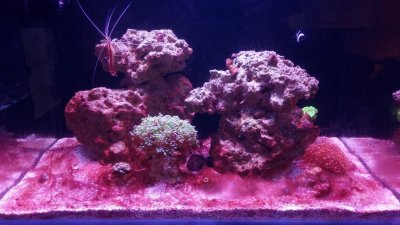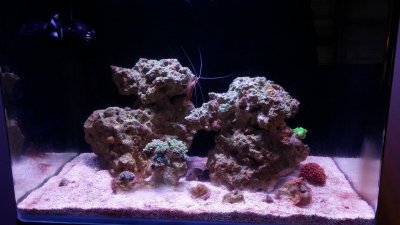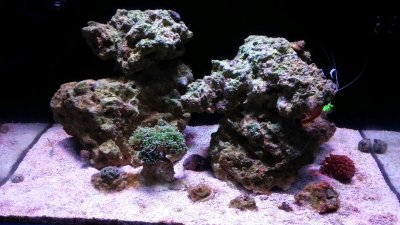Navigation
Install the app
How to install the app on iOS
Follow along with the video below to see how to install our site as a web app on your home screen.
Note: This feature may not be available in some browsers.
More options
You are using an out of date browser. It may not display this or other websites correctly.
You should upgrade or use an alternative browser.
You should upgrade or use an alternative browser.
The dreaded dinos???
- Thread starter Thor2j
- Start date
- Tagged users None
Me too.I want one that has a camera or can hook up to my Canon dslr
Fwiw I have two Dsb. One in the tank one in the sump fuge.
I ordered an amscope with a camera. Will be here tomorrow40x is enough to see the particles, 100x enough to identify fully. So any cheap 40x-1000x would do the trick. I use a $60 amscope.
Temp 77-78
PH 8.0-8.1 (all I can get in FL with AC)
Alk 8.7
CA 420
MG 1400
PO4 0
Nitrate 2-3
ORP 420-460
Mostly I'd be interested in lux/PAR, PO4 and NO3.....but post everything you can.
PAR 6" below water around 200
Sand bed around 70-80 (22" deep tank with 2" sand bed)
PH 8.0-8.1 (all I can get in FL with AC)
Alk 8.7
CA 420
MG 1400
PO4 0
Nitrate 2-3
ORP 420-460
Mostly I'd be interested in lux/PAR, PO4 and NO3.....but post everything you can.
PAR 6" below water around 200
Sand bed around 70-80 (22" deep tank with 2" sand bed)
Last edited:
Seems quick for Anthias....that's definitely an expert-level fish IMO....and 5 months in is too early....mostly too early for you. 
I have 15 years experience keeping salt water fish, just not corals.
This is my best clue.....are you feeding corals regularly? Either broadcast or target?
I feed the acans, lobos, and frogspawn once a week. Literally 1 piece of mysis spot fed. I spot feed reef roids once every 3-4 weeks and do it the night before I do the water change.
That will foul a sandbed (indeed a whole tank, potentially) in a short amount of time.
Along with any other comments, could you also post your water paramenters and measure your lights?
SG 1.025
Temp 77-78
PH 8.0-8.1 (all I can get in FL with AC)
Alk 8.7
CA 420
MG 1400
PO4 0
Nitrate 2-3
ORP 420-460
Mostly I'd be interested in lux/PAR, PO4 and NO3.....but post everything you can.
PAR 6" below water around 200
Sand bed around 70-80 (22" deep tank with 2" sand bed)
I have 15 years experience keeping salt water fish, just not corals.
This is my best clue.....are you feeding corals regularly? Either broadcast or target?
I feed the acans, lobos, and frogspawn once a week. Literally 1 piece of mysis spot fed. I spot feed reef roids once every 3-4 weeks and do it the night before I do the water change.
That will foul a sandbed (indeed a whole tank, potentially) in a short amount of time.
Along with any other comments, could you also post your water paramenters and measure your lights?
SG 1.025
Temp 77-78
PH 8.0-8.1 (all I can get in FL with AC)
Alk 8.7
CA 420
MG 1400
PO4 0
Nitrate 2-3
ORP 420-460
Mostly I'd be interested in lux/PAR, PO4 and NO3.....but post everything you can.
PAR 6" below water around 200
Sand bed around 70-80 (22" deep tank with 2" sand bed)
Our friend @reeferfoxx nattled some real nasties. Her method will prob work for you too.I ordered an amscope with a camera. Will be here tomorrow
Basically tank starvation scrub.
ReeferF where's your chrysto thread. Please and thank you.
I have 15 years experience keeping salt water fish, just not corals.
Maybe I was thinking of a different "you". Hm.
I should have asked how are you feeding them?
I feed the acans, lobos, and frogspawn once a week. Literally 1 piece of mysis spot fed. I spot feed reef roids once every 3-4 weeks and do it the night before I do the water change.
I wouldn't go any further than saying none of that "should be" necessary.
Separate discussion, really...doubt it's a cause per se.
But it is likely to at least put a damper on your corals' consumption of dissolve nutrients like PO4 and NO3 though, which is probably not what you want. Keep reading.
Without conducting a survey, this might be the most common tank pH. No worries.PH 8.0-8.1 (all I can get in FL with AC)
PO4 0
Nitrate 2-3
Zero PO4 is the one to worry about...
PAR 6" below water around 200
Sand bed around 70-80 (22" deep tank with 2" sand bed)
Just for comparison, that's around 4,000-6,000 lux on the sand bed; somewhere around 10,000-14,000 lux at six inches below the water line.
That's not a lot of light.
Possibly too little on the bottom. That level of light seems to be right around the compensation point for many corals (and plants too. Hm!).
I think your cyanobacteria is making use of available PO4 reserves bound to your calcium carbonate sand. Other algae have no access or too little access to PO4 to compete with the cyano, which tends to pool the stuff on the substrate, which can re-adsorb it, keeping it available.
Strategies
I would remove any and all PO4-removing media first. A little at a time if you want. The idea is only to make more PO4 available until you see things balancing out in your favor.
Continuously siphoning the cyano...
- ...along with the top 1"-3" of sand out of the tank (over some time) might remove the bulk of this bound PO4 the cyano is using
- ...as well as getting you more in line with a "normal" sand bed thickness, which I think is generally a good idea
- ...AND giving all the other algae a chance to get a foothold. Let your glass get REAL fuzzy beteen cleanings! That's the easiest algae in the world to manage.
I think if you balance the system by having some PO4 in the water you'll see other things competing and using up the nitrates in the water that are still available.
You might get all the effect you need before you get any particuar PO4 number on your test kit, so take it slow. Non-zero should probably be a goal though.
- Joined
- Sep 8, 2015
- Messages
- 6,514
- Reaction score
- 6,511
Forgive me. I'm not sure how that thread would apply to cyano? I was able to remove my diatom issue but my cyano still persists.Our friend @reeferfoxx nattled some real nasties. Her method will prob work for you too.
Basically tank starvation scrub.
ReeferF where's your chrysto thread. Please and thank you.
I was able to remove the diatom/chrysto and cyano went on a war path.
Little cyano background issues...
PO4 is bound in cyano and typically won't show on test results. Nitrates have been showing zeros ever since "tank starvation". I had been trying manual removal and water changes with no positive results. Cyano always grew back. So I became frustrated and decided to let it grow out.

After letting it grow out. I peeled all the red stuff off and took a turkey baster to the rocks.

I still wasn't satisfied so I performed a 30% water change. I didn't disrupt the sand or anything before or after the water change. I wanted to see if it would have an effect on growth. Shows the WC removed some growth.

Cyano growth still persists but not as bad. Also I have been slacking on water changes.
Right now my new trial is to not disrupt anything. I began dosing KNO3 to see if having a reading of 2-5ppm nitrates would help with calcium phosphate precipitation? I believe the PO4 is bound in the sand and some of the rock work. I started dosing KNO3 2 days ago. This weekend I will be adding a small refugium and a variety of pods to diversify micro fauna.
The basic soloution is seems to all invasive algal etc etc infestations is nutrient reduction then manual removal.Forgive me. I'm not sure how that thread would apply to cyano? I was able to remove my diatom issue but my cyano still persists.
I was able to remove the diatom/chrysto and cyano went on a war path.
Little cyano background issues...
PO4 is bound in cyano and typically won't show on test results. Nitrates have been showing zeros ever since "tank starvation". I had been trying manual removal and water changes with no positive results. Cyano always grew back. So I became frustrated and decided to let it grow out.

After letting it grow out. I peeled all the red stuff off and took a turkey baster to the rocks.

I still wasn't satisfied so I performed a 30% water change. I didn't disrupt the sand or anything before or after the water change. I wanted to see if it would have an effect on growth. Shows the WC removed some growth.

Cyano growth still persists but not as bad. Also I have been slacking on water changes.
Right now my new trial is to not disrupt anything. I began dosing KNO3 to see if having a reading of 2-5ppm nitrates would help with calcium phosphate precipitation? I believe the PO4 is bound in the sand and some of the rock work. I started dosing KNO3 2 days ago. This weekend I will be adding a small refugium and a variety of pods to diversify micro fauna.
Yours was a textbook perfect method.
Once the invader has been weakened other methods such as chemiclean peroxide and toothbrush or introduction of competeing organism appears to be much more effective for permanent removal. This has been my experience and my observations here on r2r.
The basic soloution is seems to all invasive algal etc etc infestations is nutrient reduction then manual removal.
Yours was a textbook perfect method.
Once the invader has been weakened other methods such as chemiclean peroxide and toothbrush or introduction of competeing organism appears to be much more effective for permanent removal. This has been my experience and my observations here on r2r.
I agree with everything stated, with one exception of hard to get rid of dynoflagelates. Standard methods don't seem to work, which is why I mentioned a few times to first fully ID under microscope. I've seen dozens of threads where reefers go through lights out, then nutrient reduction, then chemical treatments, while loosing some coral/fish due to stress, and nothing seems to work.
Totally agreed.I agree with everything stated, with one exception of hard to get rid of dynoflagelates. Standard methods don't seem to work, which is why I mentioned a few times to first fully ID under microscope. I've seen dozens of threads where reefers go through lights out, then nutrient reduction, then chemical treatments, while loosing some coral/fish due to stress, and nothing seems to work.
We need a data base better than google images too.
And IMO all those reductions need to be done to NOT stress the fish. Corals can be a bit easier. But don't stop feeding your fish.
It's gonna take time.
- Joined
- Sep 8, 2015
- Messages
- 6,514
- Reaction score
- 6,511
You stick two slides together.Got microscope today . Cane with slides but no covers. Will do it tomorrow.
Disagree with theory too little light on bottom because areas with no light have no algae.
- Joined
- Sep 8, 2015
- Messages
- 6,514
- Reaction score
- 6,511
I actually like this theory. The po4 that cyano is using is bound to the sand and rocks. It's not in the water column. I could run GFO and remove the PO4 and whatever is being leached from the sand and rocks. This would alter dkh and over all balance of nutrients. By increasing light intensity and not photoperiod you are causing more growth of cyano and of coral. During calcification nutrients(no3 and po4) are also being absorbed and the cyano is absorbing po4. By letting cyano absorb the nutrients it needs, eventually it will starve. Then by having those nutrients locked in the cyano, manual remove is a cinch.Disagree with theory too little light on bottom because areas with no light have no algae.
Won't clear the 40xYou stick two slides together.
Won't clear the 40x
Tiny drop should
- Joined
- Sep 8, 2015
- Messages
- 6,514
- Reaction score
- 6,511
Well darn it! SorryWon't clear the 40x
Won't clear the 40x
Wait I know what's up. 10x is the eye piece. 4x is the bottom piece, giving you total magnification of 40x I think you are going for 400x by combining 10x and 40x. Go for the smallest out of the 3 bottom pieces first.
My Theory So Far (Which Is A Lot Like Your Theory  )
)
If all the available PO4 is adsorbed to the sand, then it's unavailable to the rest of the system, including your test kits – and to varying extents, it's unavailable to other more desirable algae. (You want to be encouraging all of their competitors. )
)
But guess who has a 4 billion year old trick up their sleeve?
Cyano will harvest that PO4 from the sand and then "pool" it under/within the mats it forms.
It uses the sand and their own dead biomass like a battery for PO4 storage.
If you go one step further during cleanup and suck out the top layer of sand along with the cyano, you'll be removing more PO4 and more of the "problematic" sand.
Removing the critter and the whole "battery", as it were.
That should spell quicker recovery in most cases...I've seen work out enough. (There is no "every case" with cyano.)
A lot of folks have taken out the sand bed altogether once they get started with removing some. Takes a few weeks if you space it out right. Some put sand back in, some take the opportunity to go bare-bottom. Total replacement is easy and costs very little – how much is and inch or two of new sand? Sometimes this has been all that was required.
One more observation while you're doing this sand bed maintenance – swirl something like your finger or a stick around in a few places were the cyano grows and see what, if anything, comes up out of the sand.
If it's anything but pure CaCO3-white – i.e. any shade of tan or brown, etc – then you also have a detritus problem in the sand. Not just a PO4 issue.
If you find that to be the case, it's an indication of bad/too little flow or perhaps overfeeding. (But I think we covered feeding. )
)
2¢
If all the available PO4 is adsorbed to the sand, then it's unavailable to the rest of the system, including your test kits – and to varying extents, it's unavailable to other more desirable algae. (You want to be encouraging all of their competitors.
But guess who has a 4 billion year old trick up their sleeve?
Cyano will harvest that PO4 from the sand and then "pool" it under/within the mats it forms.
It uses the sand and their own dead biomass like a battery for PO4 storage.
If you go one step further during cleanup and suck out the top layer of sand along with the cyano, you'll be removing more PO4 and more of the "problematic" sand.
Removing the critter and the whole "battery", as it were.
That should spell quicker recovery in most cases...I've seen work out enough. (There is no "every case" with cyano.)
A lot of folks have taken out the sand bed altogether once they get started with removing some. Takes a few weeks if you space it out right. Some put sand back in, some take the opportunity to go bare-bottom. Total replacement is easy and costs very little – how much is and inch or two of new sand? Sometimes this has been all that was required.
One more observation while you're doing this sand bed maintenance – swirl something like your finger or a stick around in a few places were the cyano grows and see what, if anything, comes up out of the sand.
If it's anything but pure CaCO3-white – i.e. any shade of tan or brown, etc – then you also have a detritus problem in the sand. Not just a PO4 issue.
If you find that to be the case, it's an indication of bad/too little flow or perhaps overfeeding. (But I think we covered feeding.
2¢
Similar threads
- Replies
- 2
- Views
- 103
- Replies
- 20
- Views
- 268

















